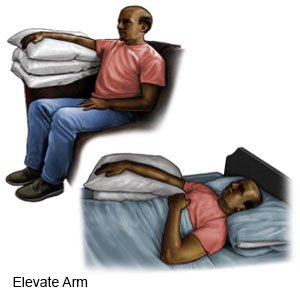Wrist Fracture in Adults
Medically reviewed by Drugs.com. Last updated on Apr 6, 2025.
What is a wrist fracture?
A wrist fracture is a break in one or more of the bones in your wrist.
 |
What are the signs and symptoms of a wrist fracture?
- Pain, swelling, and bruising of your injured wrist
- Wrist pain that is worse when you hold something or put pressure on your wrist
- Weakness, numbness, or tingling in your injured hand or wrist
- Trouble moving your wrist, hand, or fingers
- A change in the shape of your wrist
How is a wrist fracture diagnosed?
Your healthcare provider will examine you. You may need an x-ray, CT scan, or MRI. You may be given contrast liquid to help your wrist bones show up better in pictures. Tell the healthcare provider if you have ever had an allergic reaction to contrast liquid. Do not enter the MRI room with anything metal. Metal can cause serious injury. Tell the healthcare provider if you have any metal in or on your body.
How is a wrist fracture treated?
Treatment will depend on which wrist bone was broken and the kind of fracture you have. You may need any of the following:
- Medicine may be given to decrease pain and swelling. You may need antibiotic medicine or a tetanus shot if there is a break in your skin.
- A cast, splint, or brace may be placed on your wrist to decrease movement. These devices will help hold the bones in place while they heal.
- Traction may be needed if your bone broke into 2 pieces. Traction pulls on the bone pieces to pull them back into place. A pin may be put in your bone or cast and hooked to ropes and a pulley. Weight is hung on the rope to help pull on the bones so they will heal correctly.
- A closed reduction is a procedure to put your bones into the correct position without surgery.
- Surgery may be needed to put your bones back into the correct position. Wires, pins, plates or screws may be used to help hold the bones in place.
How can I manage my symptoms?
- Rest as much as possible. Do not play contact sports until the healthcare provider says it is okay.
- Apply ice on your wrist for 15 to 20 minutes every hour or as directed. Use an ice pack, or put crushed ice in a plastic bag. Cover it with a towel before you place it on your skin. Ice helps prevent tissue damage and decreases swelling and pain.
- Elevate your wrist above the level of your heart as often as possible. This will help decrease swelling and pain. Prop your wrist on pillows or blankets to keep it elevated comfortably.

- Go to physical therapy as directed. You may need physical therapy after your wrist heals and the cast is removed. A physical therapist can teach you exercises to help improve movement and strength and to decrease pain.
When should I seek immediate care?
- Your pain gets worse or does not get better after you take pain medicine.
- Your cast or splint breaks, gets wet, or is damaged.
- Your hand or fingers feel numb or cold.
- Your hand or fingers turn white or blue.
- Your splint or cast feels too tight.
- You have more pain or swelling after the cast or splint is put on.
When should I call my doctor?
- You have a fever.
- There is a foul smell or blood coming from under the cast.
- You have questions or concerns about your condition or care.
Care Agreement
You have the right to help plan your care. Learn about your health condition and how it may be treated. Discuss treatment options with your healthcare providers to decide what care you want to receive. You always have the right to refuse treatment. The above information is an educational aid only. It is not intended as medical advice for individual conditions or treatments. Talk to your doctor, nurse or pharmacist before following any medical regimen to see if it is safe and effective for you.© Copyright Merative 2025 Information is for End User's use only and may not be sold, redistributed or otherwise used for commercial purposes.
Learn more about Wrist Fracture
Treatment options
Care guides
Symptoms and treatments
Medicine.com guides (external)
Further information
Always consult your healthcare provider to ensure the information displayed on this page applies to your personal circumstances.
